The 2020 Analysis of SEO for the Ecommerce Industry

An Actionable Guide For Ranking SEO Ecommerce Stores In 2020
Hello WooNation!
We’re delivering our 3rd installment of “What It Takes To Rank In X Industry Right Now” today.
For those of you that might have missed it, here are our prior two research guides:
- The 2020 Analysis of SEO for Higher Education Marketing
- The 2020 Analysis of SEO for Local Marketing
Now, why are we doing these research analysis guides in different industries like ecommerce seo?
Because that’s how we roll at SERPWoo, doing things no one else is doing in our industry since... since Prince was on Apollonia.
When you think about it, does it matter to you what someone else publishes as dull and generic SEO advice? Like, how they did SEO on their pet gerbil food website?
Or even worse, advice from industry “guru’s” that say things like, “your content needs to be better” and that you need to provide a great experience to the end user?
How does that help you in your day-to-day duties of getting your website ranked?
What’s even more bothersome are wannabe marketers that regurgitate what they hear at a conference or in a tweet from someone they think ranks websites. Often this information is misleading, inaccurate, and most times outdated.
Want an example?
For years we have heard that nofollow links provide no value what-so-ever in ranking websites.
Did you gulp down that Kool-Aid when it was handed out like so many other SEO’s?
Maybe it was true a decade ago. Maybe enough time passed that people believed it to be so and took everyone’s word for it.
But did you stop to consider that maybe all the pundits were wrong? That the algorithm got updated and now nofollows help you?

We did here at SERPWoo, and we found out back in 2017 that nofollows helped rankings. You can read all about that research here.
People thought we were crazy and made up that nofollows helped us rank.
But then we proved it again in our study on the Higher Education industry.
And then we proved it again in our study on Local SEO rankings.
And guess what? We prove it once again in our study today about Ecommerce SEO too ( see below later on ).
Example #2 is Domain Age.
Back in 2017, we let the cat out of the bag about how no new sites ( with a few exceptions ) were ranked in the top results. Catch that research over here if you want more in-depth info.
Again, it was said we didn’t know what we were doing by a few noobs and those who don’t watch the SERPs.
But we proved it in our Higher Education research, and again in our Local SEO research study.
And guess what, we prove it a 4th time in our article today too.
And while people may scream from the tops of the hills that “domain age itself does not rank websites,” all of their arguments go back to, “if you bought a domain name in 2000 and did nothing to it, it wouldn’t rank today”.
No shit Sherlock.
Does any site rank if you do nothing to it? Are we that damn childish to think it would?
Come on.
We all know you need content and links, with a side of secret sauce and a sprinkling of significant brand representation along with that aging process.
But there is no denying the data that new sites are not ranking in the top results.
Even us marketers that have a ton of money and contacts to get content pre-written and links setup the day of our site launch, cannot beat this variable.
And no one was bringing you this information before SERPWoo wrote about it.
How could anyone?
No one else was focusing on what makes each SERP tick and breathe other than SERPWoo. It’s why I invented SERPWoo years ago when I was trying to crack what it took to rank in different niches I wanted to dominate.
I knew plain vanilla SEO advice didn’t work in niches like Payday Loans and Debt Relief. It didn’t work in Higher Education terms. It didn’t work for lots of niches and verticals.
So I set out to build a tool that could tell me everything I wanted to know about a keyword, or a niche, based on the SERP I tried to rank in.
That is what our tool, SERPWoo, is all about.
So naturally, this is why we are publishing this series of articles about “What It Takes To Rank In X Industry Right Now” so we can help you understand what it takes to get ranked today.
Something none of our competitors will even dare write about or share with you, because they don’t run real data and share it with their users as we do.
Be sure to read up our other two prior articles in this series ( see links above ) to get the Full Monty down low.
So without further ado, lets dive right into our 3rd analysis!
Ecommerce SEO - What It Takes To Rank In 2020
Staying true to form, I will not out ALL the keywords I tracked in this analysis.
Everyone moans and groans if you out their niches, so I haven’t released the full set of keywords in any prior analysis and I never will.
Also, unlike the prior analysis, I will not be including a “copy and paste/find and replace” keyword list.
There isn’t much commonality between terms in Ecommerce. Everyone sells something different!
Terms in health and beauty won’t intermingle well with auto parts — the same thing with keywords for digital goods vs. soft goods or outdoor power equipment.
Sorry folks, it wasn’t meant to be this go around on the keyword list.
Here is a small sample from the list of terms I analyzed in case anyone is curious:
- Wood Watches For Sale
- Luxury Vinyl Plank Flooring
- Cheap Handheld Vacuums
- Best Beard Oil and Balm
- Buy Carpenter Bee Traps Online
- Decorative Hair Clips for Women
- Latest Yeezys
While this is nowhere near the full list of terms, I tried to mix up the topics and various ways people type in words to find the products they are looking for.
We even included both high volume popular products and low volume specialty items to make sure we got a good cross-section of the industry.
And since I have a long history of doing SEO on Ecommerce sites and ranking them at the top of Google, I even threw in the model and serial numbers of random products, and terms that included “user manuals”, in the phrase for total completeness.
People shop online in many mysterious ways, so I wanted to make sure we captured everything we could for this analysis
Here’s what we found....
No New Domains Ranking - 4th Analysis Showing So
No surprise here since we mentioned it above.
The youngest domain was a little over a year old, and honestly, that one was ranking for a super long tail model number.
Everything else was at least two years old with more than half older than 2005.

I want to point out that while we don’t have confirmation from Google on this; they have research published about using the age of sites to help refine queries that came out earlier this year. Give it a read to get more understanding.
If you have read our prior analysis, I need not elaborate more on why you should get a grip on this and pass this info on to your boss, clients, and co-workers so that everyone on your SEO projects knows to set up the correct expectations that any new site will take time to rank the first page of Google.
Doing so will help you project costs and keep everyone aware when they can expect results.
This could be a ripe opportunity to find sites for sale in your niche on Flippa and buy ones that have age attached to them. While I don’t suggest buying older domains, buying older sites would be an excellent idea since you get the content and links associated with them.
Hell, I’d buy several and use them all to dominate a few slots on the first page if it were me.
Comparison from our prior rank studies:
- Higher Education SEO In 2020 - We confirmed that new domains were not ranking. The youngest domain was a few days away from 12 months old and was an EDU domain. The others were all 3+ years old.
- Local SEO in 2020 - We confirmed that new domains were not ranking. The youngest domain was 12 months old and a long tail term. The others were all 2+ years old.
Summary:
If you’re handling a web project where the domain is new, you need to take into account that ranking on the first page of Google might take a full 1, 2, or 3 years to play out.
Make sure upper management is informed and expects this, and that the project budget reflects such a timeline.
Not only does our 2017 study reflect this, but our analysis of the Higher Education and Local SEO industries also confirms these findings too.
Day To Day SERPs - What’s The Volatility Like
It took me back to see how calm most SERPs were for the Ecommerce industry.
Only a few outliers, which comprised large brand names and short tail keywords, showed a lot of volatility.
As a refresher, here is an example of volatility on a keyword I would not bother trying to rank for:

And here is what I found for well over 90% of the keywords we analyzed:

We are also spotting the same “Unmovable Top Rankings” as we did in our prior last two articles. A phenomenon we reported waaaaaaay back in 2014 as well too.
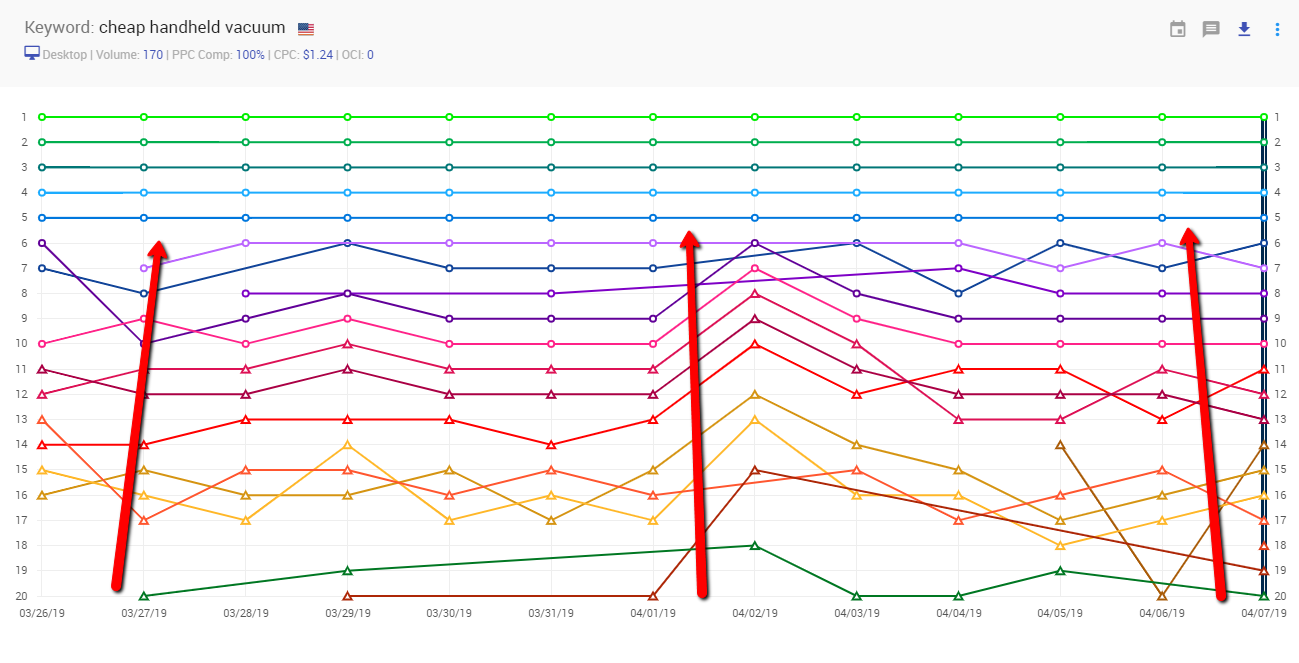
Seeing this visual over and over confirms that reaching the top 3-5 spots is what your SEO plan should be all about. Once you can get those rankings, you’re pretty much golden as long as you do nothing stupid.
It’s something I have seen for most all the keywords in our database since 2014.
If you aren’t serious about rankings, you might as well give up. Bouncing around day to day is no way to plan on hitting your metrics and goals for the long term.
When you have earned Google’s trust, you lock in the rankings.
And that only makes sense, right?
Google knows hardly anyone looks at the bottom half of the first page results and that no one hits the 2nd page. So if they can put trusted sites at the top and lock them in, most of their web spam work is done for weeks or months at a time.
Combine this with Domain Age ( see above ) and the fact most web spam comes from new domains, it’s a good racket to rank older trusted sites and keep them locked at the top for the most part. No one is clicking the bottom half of page 1, and no one is going into page 2+ to care what’s there, anyway.
Most spammers will now waste their time on new domains and bounce around never hitting the top of Google.
Before long, they will give up and try another new domain and another new tactic. Repeat the cycle over and over and eventually most of the spammers give up, never hitting the top rankings and never cashing out. At least the majority never will.
Raise the threshold on trust and age, and you weed out a ton of spam and black hats in one swipe.
Logically, it makes sense.
But for those of you that aren’t spammers trying to hit the top, it makes it so much more critical that your SEO plan is good enough and realistic enough to crack those top rankings.
If not, you aren’t going to ever rank.
If you can’t rank, you more than likely need to focus that money and effort somewhere else.
This is one reason before I start a new project, I load up my keywords in SERPWoo and track them for 90 days or more.
Before I help a client or set up my project, I want to know what it will take to realistically rank for those keywords.
Looking at the volatility and SERP changes over a couple of months within SERPWoo helps me determine my SEO plan BEFORE I build and waste money.
- I find the low hanging fruit
- I find the keywords I know I need to wait on and work harder on
- I know what kind of timeline for rankings I am dealing with
- I have a better idea of what it will cost me if I outsource my efforts
It also allows me to research who my TRUE competitors are.
If I was doing SERP research today and looked at the top 10, I might pick a site like the one at #3 here:
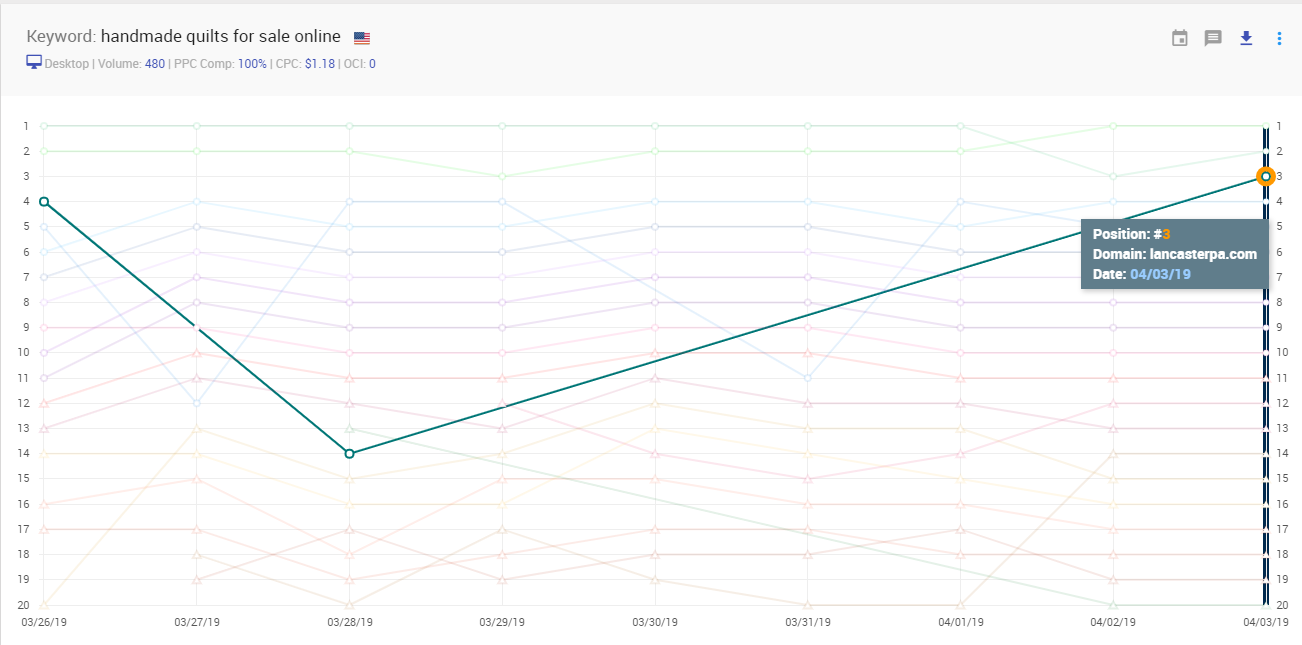
That would be a terrible choice.
It started ranking today. Before that, there were gaps in its rankings too.
I don’t know if they are bouncing from a penalty or some lousy SEO. No matter what, I don’t want to copy anything they did.
It would be much better to research a competitor who has Longevity in this SERP. Someone more like #2 and #6:
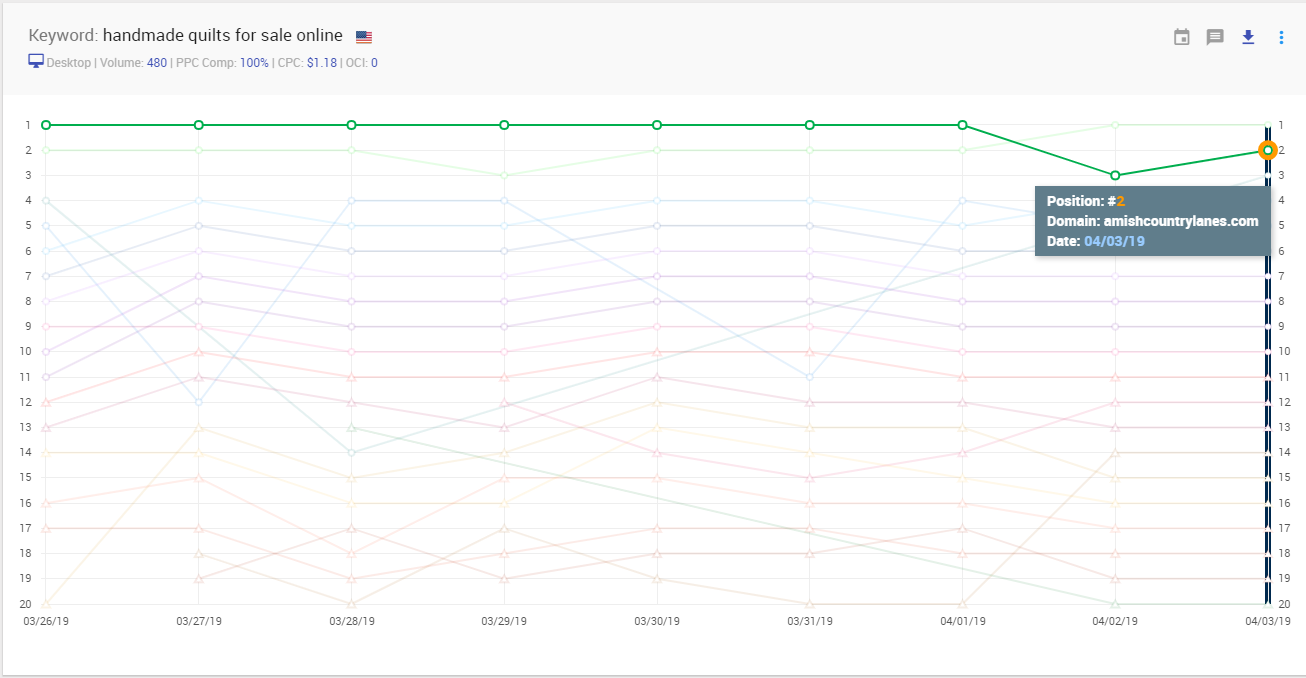
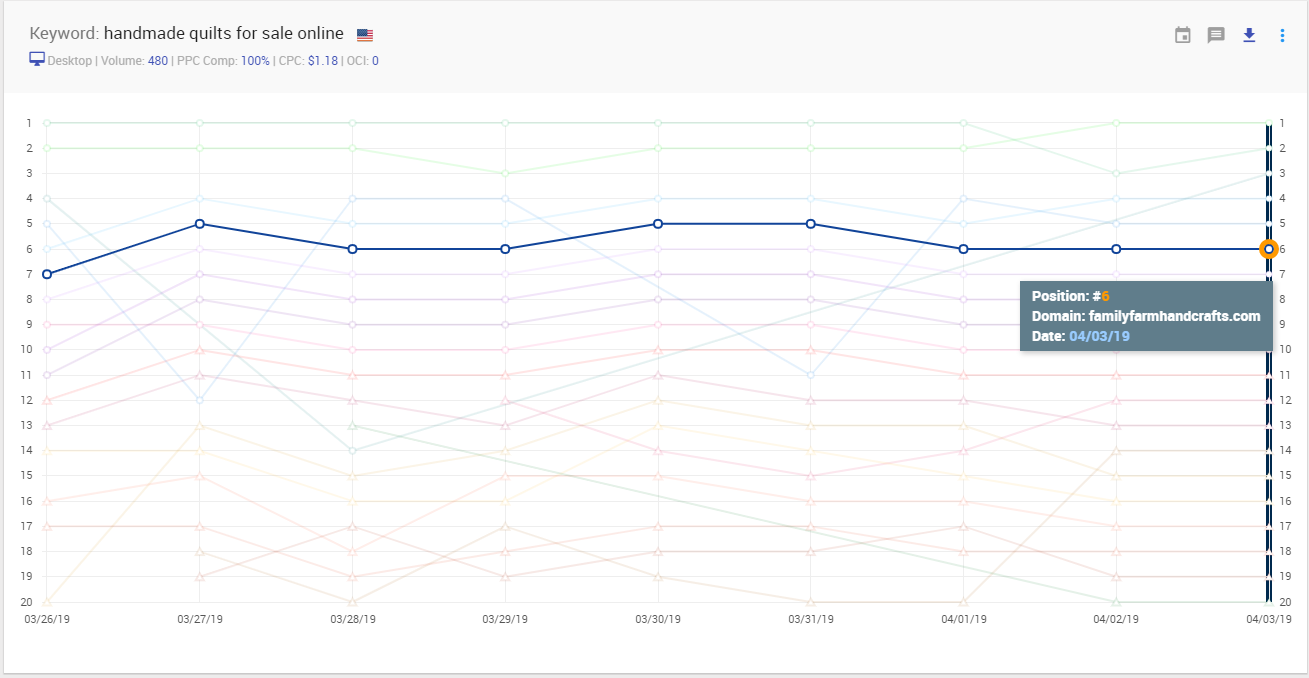
And why not the others?
Because most of the other rankings are held by:
- Etsy
- Amazon
- Overstock
- eBay
- Wayfair
- etc
I’m assuming you don’t have the bankroll and resources they have. I’m trying to keep this real here and show you actual data. If you can compete with them, by all means, research them and match/exceed what they are doing.
Comparison from our prior rank studies:
- Higher Education SEO In 2020 - The SERPs were more volatile day to day, but pockets of easier rankings still abound in less volume keywords. We saw the same pattern of unmovable top 3 rankings that barely bounced around too.
- Local SEO In 2020 - Calm SERPs that results from the locality of the keyword attached to them. Fewer competitors for most of the terms. We saw the same pattern of unmovable rankings, but many of them extended to the top 5.
Summary:
Many opportunities for low hanging fruit are still available for Ecommerce niches as the SERPs are calm.
Repeat patterns of hitting the top 3-5 positions will be harder as those sites tend not to bounce around as much, showing longevity if you can get those rankings.
Day To Day SERPs #2 - Is This The Future?
I have to give a slow clap to Google.
I mean, if I were in their position I’d do the same thing.
We didn’t find what I am about to show you in our Higher Education or Local SEO study, so I have nothing to compare it to from before. Just know that the future of Ecommerce on Google will be with AdWords OR premium feed optimization tactics.
Top of Page 1:
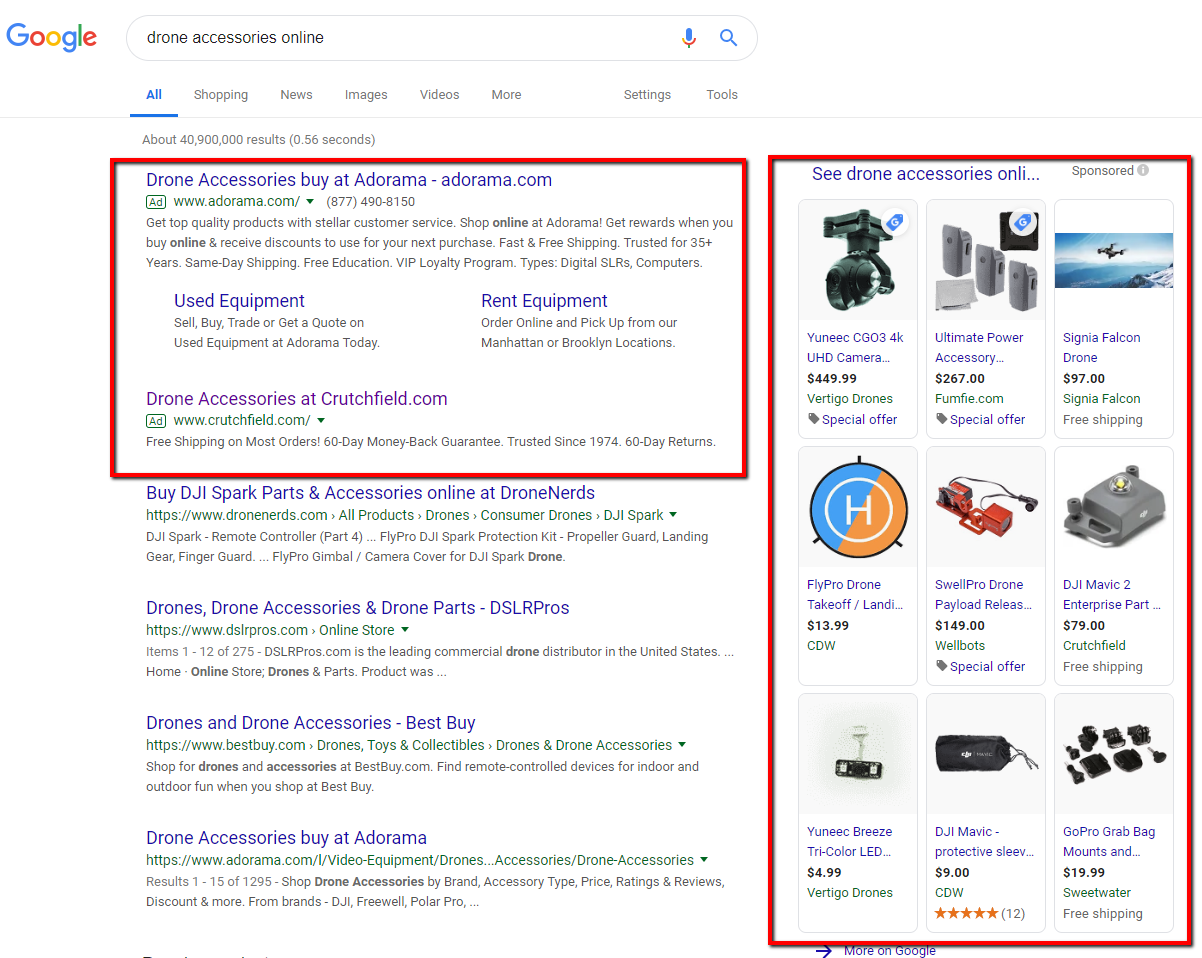
Middle of Page 1:
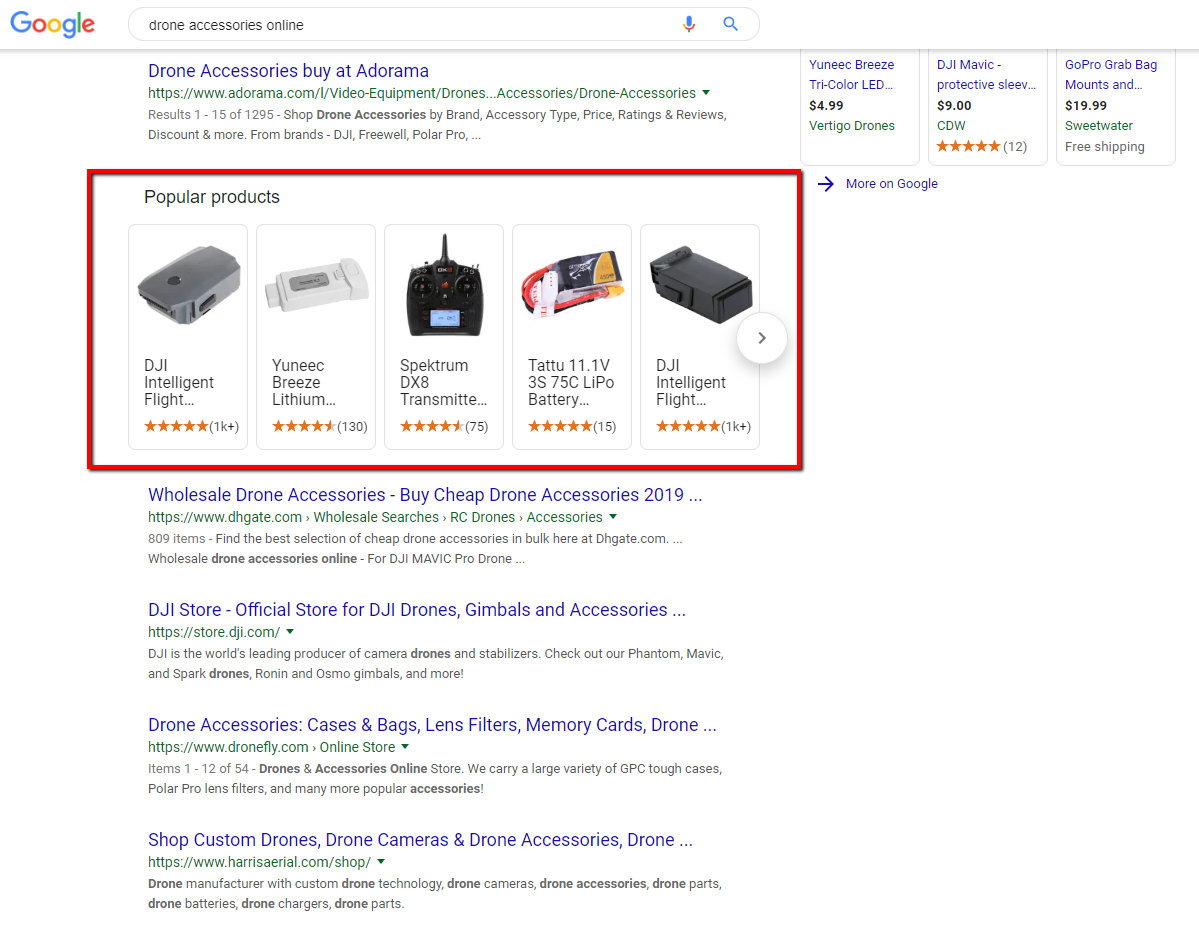
Bottom of Page 1:
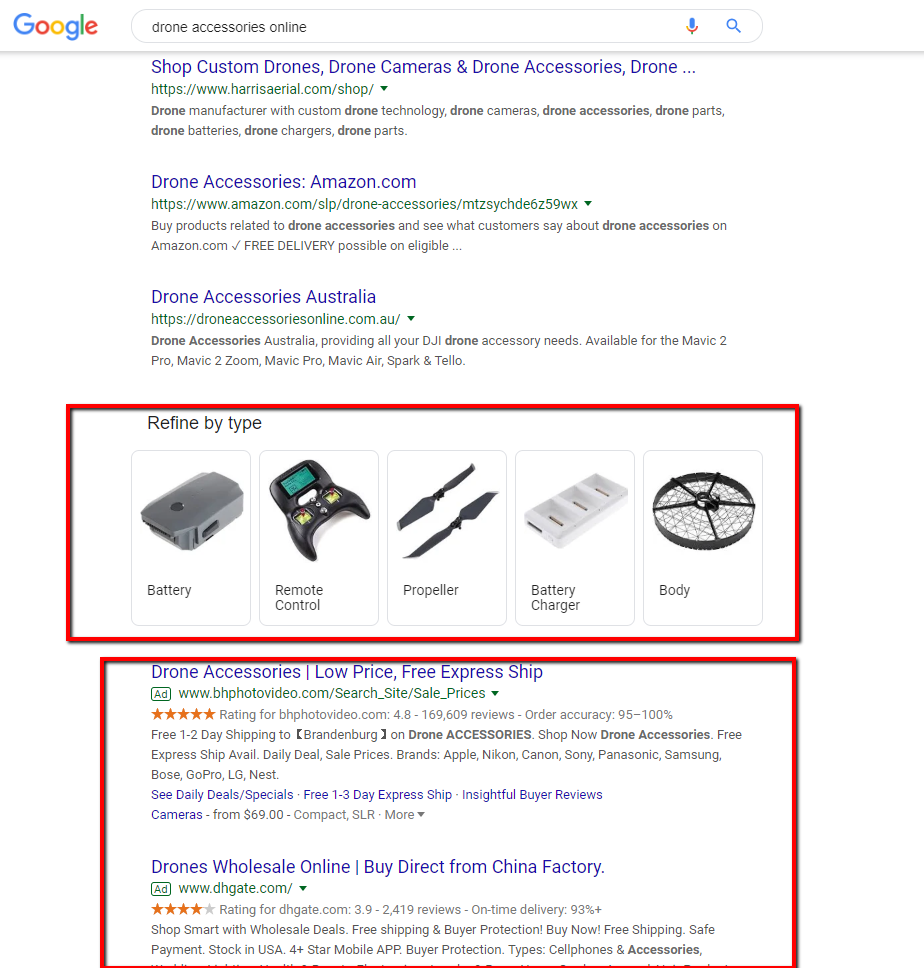
Really Google?
We have substantial product placements on the right-hand side that is showcasing nine products.
Then we have two more product placement areas in the organic listings that showcase at least 5 product each, for a total of 10.
Ads take up the top 2 spots.
Compared to standard SEO organic listings, you don’t get very many eyeballs if you aren’t paying for AdWords or doing premium feed optimization
And let’s not get it twisted, those four organic positions under the AdWords ads aren’t even safe.
I took this screenshot a little while later, and the product placement section moved up to push organic positions #3 and #4 below the fold:
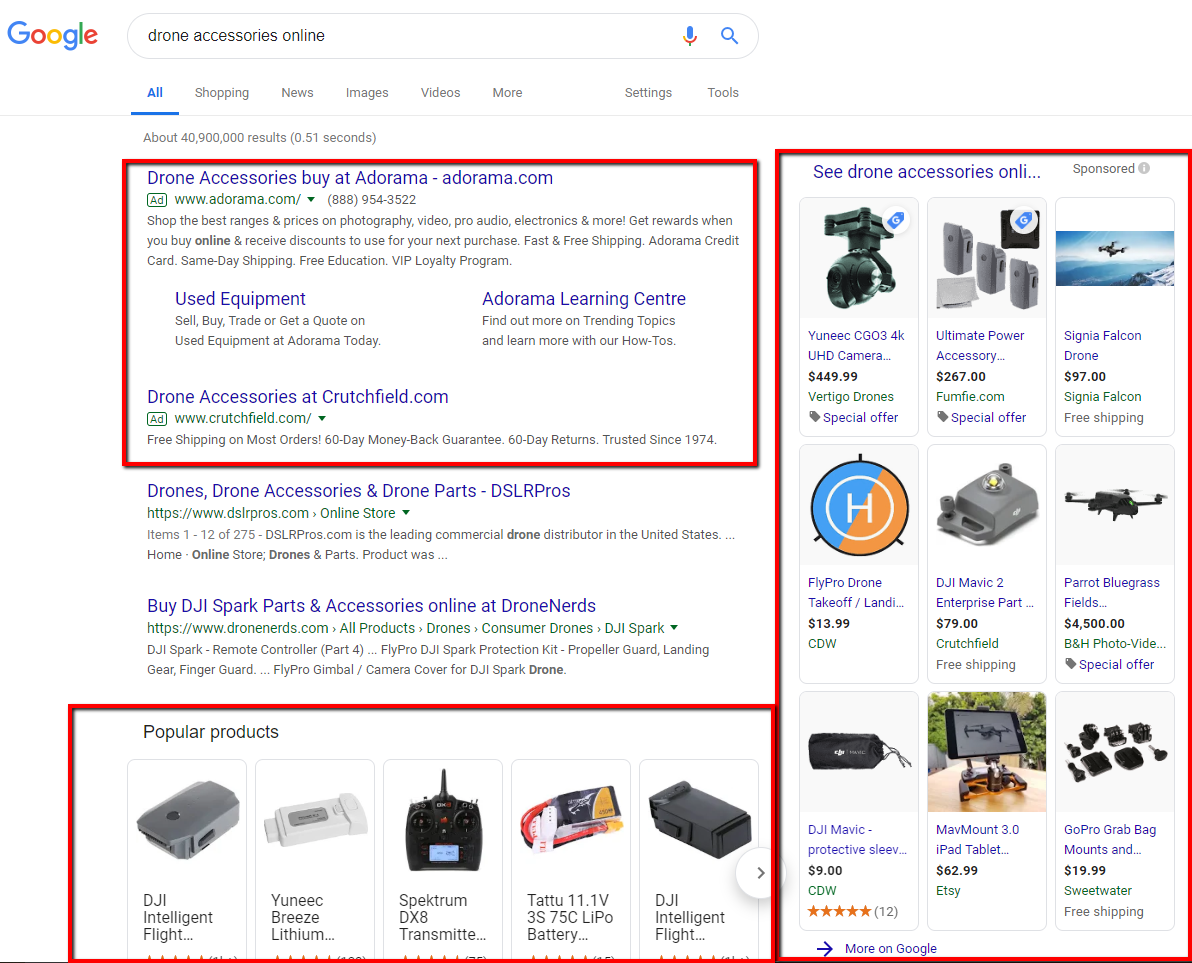
There’s money in those Ecommerce SERPs, and Google will get its share.
If you aren’t investing in PPC and feed optimizations, you will get squeezed out by Google and your competitors.
Comparison from our prior rank studies:
- None. We haven’t seen this much “eye cancer” in the other studies we did.
- But, I am sure Google will crowd those SERPs in the future. I see some inklings already in Local, but not enough to write about... yet.
Summary:
It’s a scary time to be reliant on Google for traffic if you are in the Ecommerce business. The eyeballs will follow the images for the product placements and also the “review stars” and ads. Leaving natural organic listings looking dull and below the fold where hardly anyone visits.
If you haven’t changed tactics to take advantage of this, this is your warning shot.
Nofollows - 4th Study Proving They Help Rank Sites
If you haven’t read our Quora study and two prior Higher Education and Local SEO studies, please do so right now.
We were the first to study and report how nofollow links helped us rank back in 2017. A time that no one believed nofollows carried any weight in helping rank websites.
Not only were we the first to study and report on these findings, but we also followed this up with evidence from our Higher Education and Local SEO guides. We showed that nofollows were helping websites in those industries too.
No surprise, but our data shows how nofollows help Ecommerce sites as well.

Awesome right?
I expect no less than ten new link sellers per day popping up and selling these ooey gooey delicious links types now. Expect some at Fiverr and shady forums near you in the future.
I explained this before, but don’t you think these findings make sense?
When SEOs zig, Google is going to zag.
As loopholes get exploited in rankings, things will change as a result.
I don’t work at Google, but let’s break this down:
- This could be a change in the algorithm that started back in 2017 or before. As things get tweaked in many areas, nofollows became a stronger factor. This could have been 100% unintentional on Google’s end.
- Maybe after many many years of telling people, nofollows carry no weight and people drinking the Kool-aid, Google intentionally removed any filter off nofollows to buffer the impact of shady link sellers that pretty much never sold nofollow links in their services. Everyone wanted dofollows with good TF and PA metrics. Since no one is watching, Google pulls the sleight of hand.
- You have a little of the first bullet point and a little of the second bullet point. No matter what, the links are working.
And while I hate to beat a dead horse, you have to be looking at the data presented in front of you.

I don’t care what the reason is. I’m ready to pull the SERPs and dig into what’s working right now in specific niches I might want to rank in.
And that’s the key to ranking with Google.
I don’t drink the Kool-aid, and I don’t want to see you do it either.
Comparison from our prior rank studies:
- Higher Education SEO In 2020 - Yep, we saw them helping here.
- Local SEO In 2020 - Yep, we saw them helping here too.
- Quora Hacking ( from 2017 ) - We first discovered this trend in this article, so yes they were working then as well.
Summary:
Get some of these links and see what it takes to outrank your competitors.
Nuff said.
Images, And More Of Them, Are Winning In Seo For eCommerce Websites
Especially if you throw in that alt text.

And who’s surprised here?
We are talking Ecommerce folks. People want to see what they are buying, and they want to see a lot of images if possible.
Google knows this, so they are looking for it.
It’s not exciting for me to find this. I expected it. Any good digital marketer should have.
What’s surprising is the validation that every SERP behaves differently and has its own guidelines and metrics.
What works for one keyword or SERP, might not in another.
And yeah, that’s 100% why I built SERPWoo in the first place. To find out what precisely was working for me in my keywords and SERPs. It’s why we invented SERP tracking to replace outdated “rank tracking” that all our competitors focus on.
Anyway, I expect no one in Ecommerce to be selling online without images, so I will keep this section brief and to the point
The lesson here is to get those alt texts in place and add in more images if possible.
Comparison from our prior rank studies:
None. This is the first we have seen images take a significant role in helping with rankings.
Higher Education and Local SEO SERPs did not seem to be influenced by having images.
Summary:
If you're playing in a niche that is heavily Ecommerce focused, you better have those images and alt tags EVEN IF you are not selling anything yourself. Otherwise, you may never rank.
If you are selling, look at optimizing alt tags and getting more images for your pages.
Content-Length, Playing A Factor In E-commerce SEO In 2020
Now, this is something we saw with our Higher Education study.
Not at all in our Local SEO findings though.

And it makes perfect sense.
People want as much information as they can get BEFORE they make a purchase.
They want to see images. Up close and detailed photos. Pictures of every angle and side. Images of the product being used.
Why not the same for reading and asking/answering questions too?
Images only do so much.
I want to know about returns, where the product was made, how much it weighs and if it’s dishwasher safe. You know, the essential ponderings in life.
It’s one reason people buy from Woot and Amazon.
It’s why copywriting works so well.
And if you can duplicate this and hammer in a lot of good detail and copy into your Ecommerce pages, you might have a shot at ranking on the first page too.
I mentioned in our Higher Education study that more content also helps with getting more of your target keywords in the pages/overall website. This could very well be the case for Ecommerce since we found out keywords are playing a significant part for ranking ( see below ).
Comparison from our prior rank studies:
- Higher Education SEO In 2020 - Yes, we saw content length a factor for ranking on the first page.
- Local SEO In 2020 - Not at all. Wasn’t a factor that came up in our findings.
Summary:
I’m a huge believer you need to match and exceed your competitors when it comes to ranking in Google. If the average word count in my SERP is 1,200 words, I will write 1,500 words.
When I noticed that my specific SERP is also showing correlation with rankings on that content length too, I will turn that 1,500-word article into a 1,800-word one.
From looking at the averages from this study and our Higher Education piece, I wouldn’t go lower than 2,000 words for any page on my site going forward.
Keywords, Keywords, Keywords. Oh My
The more studies I do, the more I find that frequency and location of keywords are a huge factor in how Google interprets your page and what it should rank for.
I mean, this isn’t new or groundbreaking data.
But coming up in my day, you had to be wary of “stuffing” keywords on your pages. This lead to people trying to figure out how to do less on-page, and more off-page.
But I’m seeing a lot more of the good ole days were now the off-page is taking a backseat to the on-page. Especially when we look at what Grindstone told us about anchors used in links.
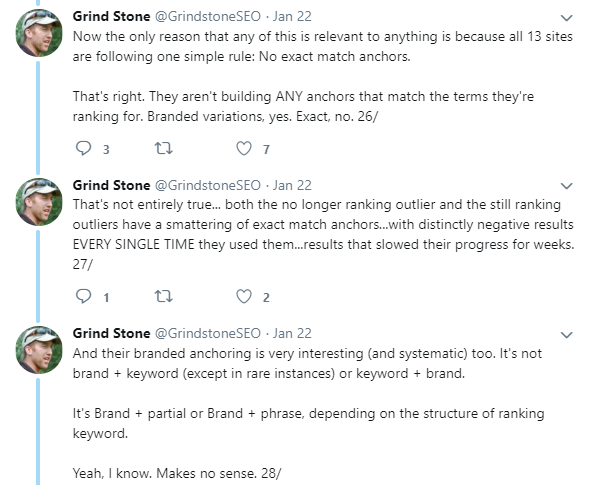
Let’s look at where keywords on your page are helping the most.

In all our studies, we are seeing the H1-H3 tags playing significant roles in keyword placement.
It is followed up by the LI tag in all studies too.
That’s hard to ignore.
We also get a taste again for keywords in SCRIPT tags and keywords used in the top 3-5 most used phrases which showed up in at least one other study ( but not all studies ).
Now, we get a new finding which is keywords in the NAV Tag. A high signal to Google that you’re on the correct page or can click over to a new page that contains the product you want to know more about.
When you tie LI tags to this NAV tag finding, things get interesting.. no?
Google is putting emphases on breadcrumb navigation if it locates your keyword there.
That tells me that:
- I need to make sure my navigation on my site uses the NAV and LI tags.
- I need to make sure my keyword is in that navigational menu.
- I need to make sure other items in the navigational menu contain keywords ( categories, etc.)
- Maybe I can fire off this navigation within a SCRIPT tag? ( to test and see, which we found in our Higher Ed study and found in this one too )
I left the “Body - Size in Kb” data within our findings to highlight that Word Count ( seen earlier ) could be tied to the fact we can get more keywords “stuffed” into our page and content.
Larger body sizes and more word count tie into the “Keywords In Body - Count of” data as well where we see more of our keywords within the content.
Comparison from our prior rank studies:
- Higher Education SEO In 2020 - Yes, having keywords in certain sections like H tags and LI tags was a good ranking signal
- Local SEO In 2020 - Yes, having keywords in certain areas like H tags and LI tags was a good ranking signal.
Summary:
We have known for years that having keywords is critical to ranking.
But did you know where to put those keywords properly? When I started in SEO back in early 2000, you could stuff keywords and put them anywhere.
Then as time past, it became fashionable to put them in just the Title tags, link anchors and spread them out sparsely.
At this moment, having more keyword frequency ( along with more content ) and getting keywords in specific areas of your content is working as a correlation for rankings.
Backlinks, Not Going Away.
We all know backlinks are critical.
With so many people claiming that Google is moving away from this, I don’t see it happening anytime in the next few years.
I don’t feel Google will move away from this. I think they will keep altering how they measure backlinks.
Why?
Because so many people do backlinking wrong.
So much so, many of the algorithm changes Google has implemented has been focused on backlinks and linking in general.
They have too much invested in figuring out what natural and organic backlinking looks like to up and throw that away anytime soon.
I’ve already pointed out in our two earlier studies that backlinks from High Relevancy Domains count more than backlinks from High Authority Domains ( thanks Grindstone ). Even a backlink from a High Relevancy URL is scoring over one from a High Authority Domain.
I’ll let Grindstone tell you again in case you missed it in our other two studies.
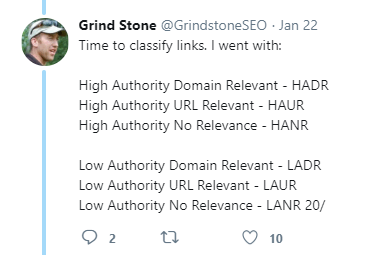
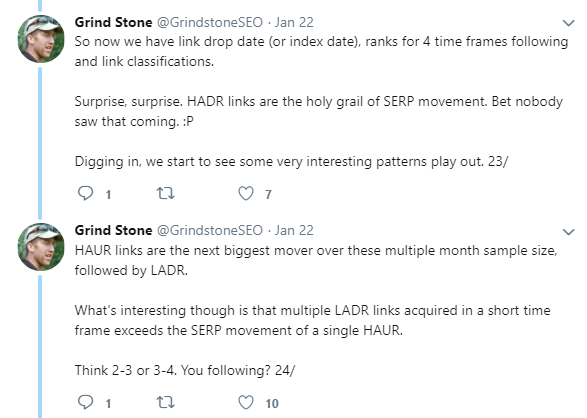
This leads me to believe that your content and keywords in your content are becoming the more critical asset in ranking for your desired keywords.
You won’t be able to massively spam your link and link anchors like you could back in the old days to influence your rankings, it will have to be more about content.
And when you think about it, what’s harder to create and outsource. Links or content?
We have a ton of tools that have been built over the years to help with link building in mass:
- GSA SER
- Xrumer
- RankerX
- SEO Autopilot
- SENuke
- and at least 1,000 more I’ve forgotten. I’m too lazy to research again.
To top it off, we have 1,000’s of link building services too using a manual or semi-automated process to get those links like:
- Guest posts
- PBNs
- Press Releases
- Comments on forums and blogs
- Guestbook links
- and at least 1,000 more I’ve forgotten. I’m too lazy to research again.
Building links was easy.
Writing content was harder.
We had fewer tools available for writing content overall and fewer services for them.
When you add on the word “quality” to content writing, you end up with a tiny pool of resources to find good content that didn’t cost an arm and leg.
Compared to link building, I could spend $200 and build all the links I wanted with GSA SER or Xrumer.
The same amount of money would barely get me one good article that was worth much and optimized for SEO if I outsourced it.
Google moving to have your content weigh more than links is a natural move to raise the threshold to keep spammers at bay. Just like I mentioned with domain age earlier in this article.
Here’s what we found for backlinks in our research for Ecommerce.

We find exactly what we have known all along, that more backlinks correlates with better rankings.
The secret is in how you use those links and what kind of content they point to.
Comparison from our prior rank studies:
- Higher Education SEO In 2020 - Yes, having more backlinks and the right anchors correlates with ranking better for Google.
- Local SEO In 2020 - Yes, having more backlinks and the proper anchors correlates with ranking better for Google.
Summary:
Get more links, with brand anchors, and let your content do the ranking for you.
Conclusion of our 2020 Ecommerce SEO Plan
Ecommerce SEO is enjoying several factors we have seen in prior studies:
- Aged domains
- Nofollow backlinks
- Longer content
- More keywords, and keywords in the right places ( such as H tags and LI tags )
- More backlinks ( dofollow and nofollow )
And a few things unique to its niche :
- Images, and lots of them ( with alt text )
- SERPs that do not reward organic listings most times
- Keywords in the NAV tag
When setting out to build a new Ecommerce site, you should be paying attention to everything we outlined above to ensure you can get rankings within the next 12-24 months.
If taking over a client’s website and trying to help them rank, I would look at getting their breadcrumb navigation set up correctly, producing more images and text content on each page, and making sure you get keywords in specific areas of the site like H tags which would include H1, H2, and H3 at the least.
With linking, both examples would need a fair amount built up from other highly relevant domains and URLs with brand anchors coming back to the page. I would focus on this tactic more than trying to secure high authority links that are not relevant with anchors that match the exact name of the product or target keyword you want to rank for.
If you want to get more frequent detailed reports like this, sign up for a paid SERPWoo account. We send out monthly exclusive guides like this to all our paid members that include private content found nowhere else online!
Shameless Request
Can you spare a few seconds and share this article to your network on Twitter, Facebook, Reddit, LinkedIn, or favorite Slack community?
We’d love it if you could help us spread this article to others because it allows me to get feedback to keep producing case studies and educational materials just like this for you and thousands of other readers.
We want to help you become the best digital marketer possible, so help ensure we can do that by spreading our updates to others!
